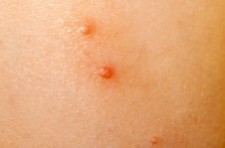Molluscum contagiosum
Molluscum contagiosum is a common, mild skin disease caused by a pox virus. Although it can happen at any age, it is most common in children 1 to 10 years of age.
What are the symptoms?
Tiny “pinpoints” appear on the skin 1 to 6 months after exposure to the virus. These turn into pinkish-white bumps that are smooth and shiny, have a dip in the middle and have a milky-white cheesy-like material inside. Bumps can appear anywhere on your child’s body. Most children get 1 to 20 bumps, but some can have hundreds. They may become itchy, sore, red, and/or swollen.
How does it spread?
Molluscum contagiosum doesn’t spread easily from person to person and outbreaks are rare. It can spread by direct (skin-to-skin) contact with bumps, or indirect contact (e.g., bedding contaminated with material from the bumps, sharing of towels). Scratching can spread the infection from one part of the body to another.
Once the bumps are gone, the virus is gone and you cannot spread it to others.
Is molluscum contagiosum serious?
Molluscum is harmless and will disappear without treatment. Each bump usually lasts about 2 months but children may continue to get new bumps for months or even years. If the bumps are bothering your child, a doctor can prescribe a cream or, if there are not too many bumps, remove them by scraping or freezing.
What do I do if my child has molluscum contagiosum?
- Bring them to the doctor to confirm that it is molluscum contagiosum.
- Wash your hands often. This is important to prevent spreading the infection.
- Encourage your child not to scratch or pick at the bumps.
- Make sure your child doesn’t share towels, clothing, or other personal belongings with others.
Should I cover the bumps?
No. Covering is not necessary. When your child is swimming or doing contact activities, you can cover bumps that aren’t covered by clothing with a waterproof bandage. Change the bandage daily or when dirty. Keeping bumps tightly covered for long periods can lead to bacterial infections and scarring. If your child picks at the bumps, cover them with a loose gauze dressing.
Can my child go to child care or school?
Yes. Once your child’s doctor confirms that it is molluscum, your child can continue to attend child care and/or school. Remind them to wash their hands often.
Reviewed by the following CPS committees
- Infectious Diseases and Immunization Committee
- Public Education Advisory Committee
Last updated: August 2021

